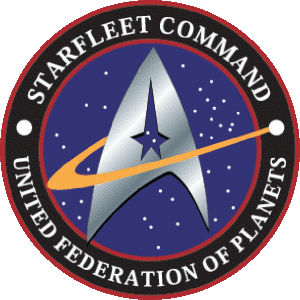

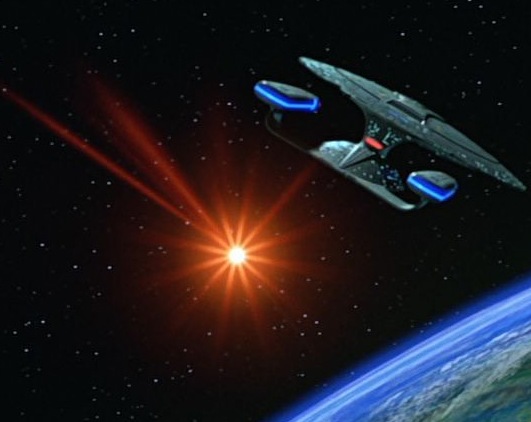
Photon torpedoes are main Federation anti-capital ship weapon. They are a warp-capable matter-antimatter tactical weapon, and are sometimes used as a strategic weapon. Photon torpedoes are also used by the Romulan Empire (in addition to their unique plasma torpedoes), Klingon Empire, Cardassian Union and many others, making it most widespread anti-ship weapon in Star Trek universe. Photon torpedoes are shielded, which allows them to pass throught the shields of starship firing them by matching shield frequency or borrow themselves into planet's crust or star. It is also only logical explanation for torpedo glow; also, in "Half a Life" photon torpedoes that are fired at star with intent of restoring it are capable of reaching the star's core, and Timicin reports that "their shields are holding". The torpedoes then sit there for over six seconds waiting to detonate.
Torpedos are, as said before, primary Federation weapon when it comes to starship combat. As such, torpedo yields are very important for st-v-sw discussion. There is lot of evidence, which often seems conflicting at times, especially when we take all 3 TNG-era series (TNG, DS9 and VOY) into accaunt. TNG is by far most consistent of these three, so I will start with analysis of TNG instances of torpedo fire. One of important aspects of photon torpedoes is their variable yield, so when analyzing maximum yield of torpedoes, we must take only incidents where we are informed that maximum yield was in use.
Variable yield evidence:
Picard : "Set them for a display blast a thousand metres short of the planets surface."
(TNG: "Code of Honor")
Federation starship Pegasus, fitted with experimental (and illegal) interphase cloak, which allows ship to "phase out" and pass throught matter unhindered, has been lost. It is later found partially embedded into rocky asteroid, and USS Enterprise D is sent to destroy it.
These pieces of dialogue are important for determining yields (important blaces are in italics):
Pressman: "The Pegasus was prototype. Experimental engine, new weapon systems, in fact some of our designs were used in constructing the Enterprise. There are lot of things that Romulans would like to have their hands on".
Picard: "What are our orders?"
Pressman: "To find Pegasus. Salvage if possible, destroy if necessary."
and later:
RIKER: I recommend we destroy the asteroid. It would take most of our photon torpedoes, but it would preclude any possibility of the Pegasus falling into Romulan hands.
PRESSMAN: What the hell is the matter with you? Destroy the Pegasus before we've even taken a look at it?
RIKER: I thought it was more important that the Romulans...
PRESSMAN: Well, you were wrong! We have a chance here to change the balance of power in this quadrant, but we can't very well do that if we destroy the Pegasus, now can we?
RIKER: No, sir.
So it is clear that they could destroy Pegasus only by vaporizing asteroid itself to prevent Romulans from finding the cloak - given Federation hull strength, vaporization of asteroid is only possible solution. To do that, they needed to vaporize asteroid.
Here are screenshots of the asteroid:

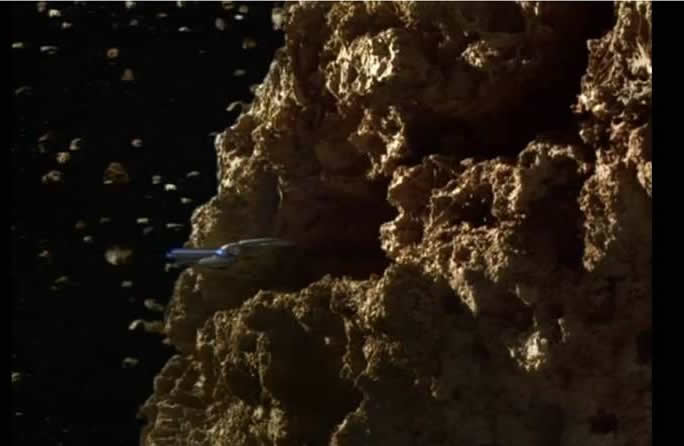
Hole throught which the Enterprise flew into the asteroid is clearly visible at the left side of asteroid in first screenshot (inside yellow circle). Hole is 5 mm wide and 4 mm high; when compared with Enterprise, height comes off as 800 meters, for 200 m/mm. Asteroid is 75 mm long and 35 mm wide on average. With 1 milimeter being 200 meters, we have value of 15 000 meters for asteroid's length and 7 000 meters for its average width, for volume of 5.77 x 10e11 cubic meters. That volume is identical to volume of a sphere which is 10 330.6 meters in diameter. By using Wong's asteroid destruction calculator we arrive at figure between 4240 and 8250 gigatons. Due to the asteroid being rocky, and due to Riker's comment about not wanting to transport throught that much of solid rock, I will take former. I also did not include "cave" due to objective being to vaporize the starship inside, and starships are generally more difficult to vaporize than asteroids; also, asteroids are never comletely homogenous, so we can assume that there were metallic elements (most important iron, as it is most common), which should neutralize "cave" in calculations. That wiev is supported by Worf's comment about Enterprise encountering shifts in magnetic field density, which points to iron being present.
Enterprise was about to use "most" of her torpedoes in order to vaporize asteroid. In "Conundrum" it is stated that she carries 250 photon torpedoes; so "most of" could mean anywhere between 135 and 245 torpedoes, which means individual torpedo should be between 17.3 and 31.4 gigatons.
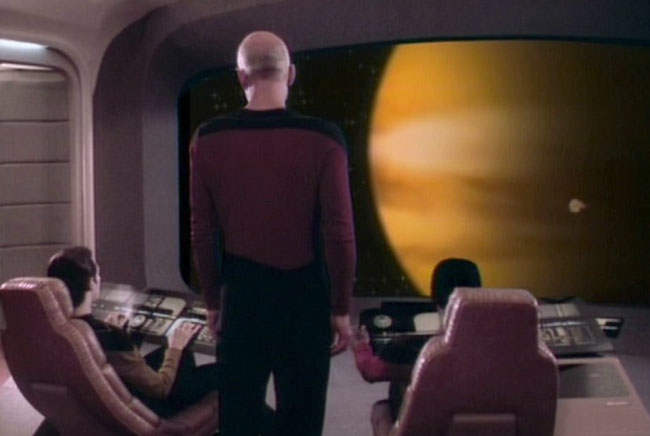
Here we have explosion of torpedo against planet. From previous events it is clear planet is M-class (Starfleet designation for Earth-like planets). Shockwave seems to be 150 kilometers in radius. With Wong's calculator we arrive at value of 507.5 megatons.
Note: It is stated in DS9 episode "Apocalypse Rising" that full spread of photon torpedoes is enough to destroy the "Klingon High Command and everything else within a few hundred kilometers", supporting yields in hundreds of megatons. Tsar bomba, 100 megaton weapon, could, in theory, level urban areas out to distance of 60 kilometers, and devastation out to 100 kilometers. KHC is planetoid-based, so blast effects probably come into play.

Here is last frame before torpedo Voyager fired exits screen. From events in episode it is clear that Voyager fired roughly straight forward. We have measurements below.


From that, we can calculate asteroid as being 374 meters long, and 222 meters wide on average. Using volume of equivalent cylinder, we arrive at 14 476 628 cubic meters.
Nickel-iron asteroids are composed from iron and nickel, and occasionally other elements like copper. However, I will use pure nickel-iron composition, with nickel forming 15 % of asteroid (average between actual extremes of 5% and 25%) and iron rest of it, since these seem to be most common, and no traces of other elements were specified.
So we have 12 305 134 cubic meters of iron, and 2 171 494 cubic meters of nickel. I will take starting temperature as -270 ° C, or 3.15 K. (0 K is -273.15 ° C)
VAPORIZING IRON
To vaporize any element, we need to:
a) raise its temperature to point of melting
b) melt it
c) raise its temperature to point of vaporization
d) vaporize it
Specific heat capacity of iron is 3.537 J x cm^(-3) x K^(-1). Its melting point is 1811 K, and boiling point is 3134 K. Its heat of fusion is 13 810 J/mol and heat of vaporization is 340 000 J/mol. Its density is 7.874 g/cm^3, and 1 mole of iron weights 55.85 grams (due to its mollecular weight being 55.85).
So energy required per steps is:
a) 9.07 x 10e16 J
b) 2.396 x 10e16 J
c) 5.758 x 10e16 J
d) 5.898 x 10e17 J
for total of 7.62 x 10e17 J.
VAPORIZING NICKEL
Specific heat capacity of nickel is 26.07 J x mol^(-1) x K^(-1). Its melting point is 1728 K, and boiling point is 3186 K. Its heat of fusion is 17 480 J/mol and heat of vaporization is 377 500 J/mol. Its density is 8.908 g/cm^3, and 1 mole of nickel weights 58.69 grams.
So energy required per steps is:
a) 1.48 x 10e16 J
b) 3.795 x 10e16 J
c) 1.253 x 10e16 J
d) 1.244 x 10e17 J
for total of 1.897 x 10e17 J.
So, total yield for "Rise" torpedo is 9.517 x 10e17 J or 227.46 megatons.
However, vaporization was not expected to be complete, so we are left with total of 180 to 200 megatons. While it is not stated that torpedo was fired with maximum yield, it handily removes argument that "Pegasus" involved fragmentation, not vaporization, of asteroid.
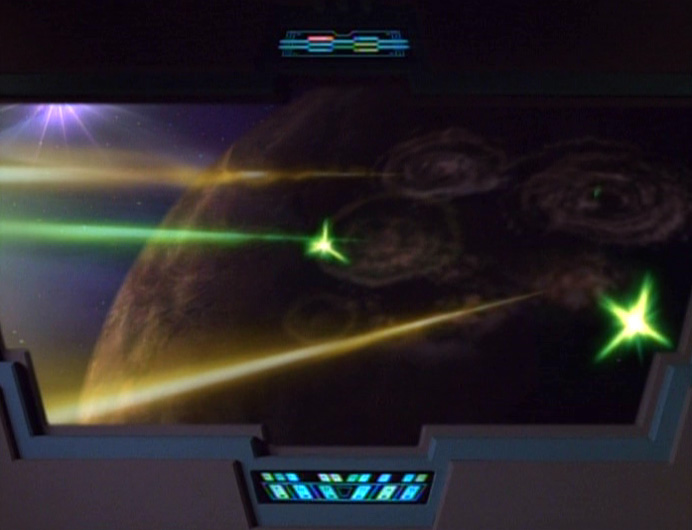
Here we see bombardment in "The Die is Cast". Shockwaves seen correspond to what is expected from underwater nuclear explosion.

Torpedo explosion (outlined in yellow) has diameter of larger axis (which I will use for measurement, due to optical distortion in vertical axis from curvature of planet) is approx. 1/6th of planetary diameter (1/5.9). Assuming normal planet (diameter of Earth is 12 756 km), that is 2 162 km. Searching for it in Wongs calculator results in value of 31.9 teratons for torpedo. However, it might also be that effect was simply variation of "The Chase" chain reaction effect.
Only way to make TDiC DET AND to fit TNG is by assuming tritanium asteroid in "Pegasus". Given energy required to melt tritanium (vaporization is no longer required to destroy Pegasus inside) per-torpedo yield could go up to 6.08 x 10e19 to 2.44 x 10e20 MJ. That is 14.5 to 58.3 petatons per torpedo; my old calculations show that literary taking Tain's line about destroying crust in one and mantle in five hours results in low end of 50 petatons per weapon. However, coupled with previous chain reaction theory, it means that Die is Cast is basically useless for determining weapons yields.
On the other hand, low end as calculated by Graham Kennedy - 24.5 gigatons - fits nicely within values calculated for "Pegasus".
CONCLUSION: Federation photon torpedoes as of TNG are from 17.3 to 31.4 gigatons in yield.
Also, in TNG episode "Genesis", which is set after "Skin of Evil", we learn that Worf has increased yield of torpedoes by 11%. If these upgrades were kept, then yield of photon torpedoes should be 19.2 to 34.85 gigatons.
2 seconds after Data reports that "warship is 300 000 km from the Phoenix", we have this situation:
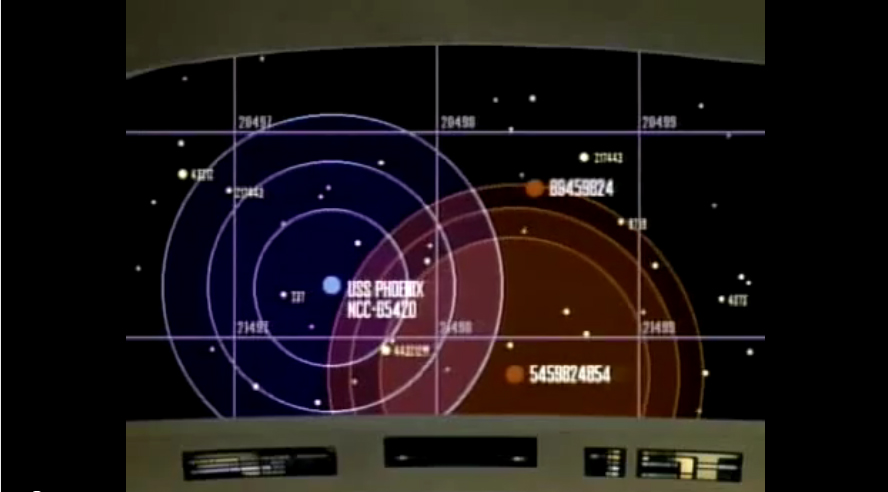
Distance between "Phoenix" and Cardassian ship is 61 milimiter, with Phoenix' weapons range being 51.5 milimeters and Cardassian warship's range being 56 milimeters. In next 2 seconds, "Phoenix" closes 4 milimeters, so we can conclude that 300 000 km = 65 milimeters, giving us 4615.3846 kilometers for 1 milimeter. With that, we have Phoenix's weapons range as being 237 692.3 kilometers and Cardassian warship's weapons range being 258 461.5 kilometers.
Later, Phoenix fires weapon that seems faster than photon torpedoes, so I presumed these were phasers. Analysis on adequate page.
CONCLUSION: Photon torpedoes, as of 2350s, have effective range of 238 000 km.
Some on SDN have claimed that episode "Genesis" proves low yield for photon torpedoes.
That, however, is just intentional misinterpretation of sources. We are never said that the torpedoes WERE fired with 11% greater yield; to contrary, torpedoes also got new guidance system, so it is logical that you will lower yield of torpedo before firing it - actually, you will only load torpedo with enough reactants to achieve visible results (destroying asteroids) in order to avoid damage to ship by possible stray torpedoes, while at same time testing any possible modifications to reactant storage and reaction chamber. Anyway, "Genesis" came after both of aforementioned TNG episodes, and has later stardate than other two (47653.2 when compared to 47457.1 for the "Pegasus" and 41601.3-41602.1 for the "Skin of Evil"), which means that, provided Worf's upgrades were kept, torpedoes after "Genesis" should be 19 to 35 gigatons in yield.
Objection regarding range also appeared. Most of ST battles are short-range affair; however, contrary to some claims, that does not exclude long-range battles. Philosphy behind short-range battle is simple... move in as close as you can, shortening enemy's response time and making it possible to exploit any possible gaps in weapons coverage while pouding enemy ship with surgical fire. Also, closing inside enemy's formation can make them more cautious in firing and less able to exploit numerical strength by concentrating almost entire firepower on individual ships, and it makes it easier to hit specific systems to knock out enemy ships faster.
Long-range combat certainly isn't limited to warp speeds... we have several examples from TNG and TOS which have long-range combat definetly occuring at impulse. In "A Matter of Honor" Riker, needing ships in transporter range, advises Klingon commander to wait until 40 000 kilometers before attacking. "The Wounded" is unclear whether combat is occuring at warp or impulse speed, but due to VOY episode "Human Error" giving range of torpedoes at warp as 8 million kilometers. In TOS episode "The Changeling", we have 90 000 kilometers effective range for photon torpedoes against 1 x 0.25 meter object at impulse. "The Ultimate Computer", also from TOS, gives us 200 000 km range for capital ship combat, at warp.
"Wounded" example itself is definetly that of sublight combat - ships move way too slow for it to be FTL.
Size of the explosions is also one popular objection in regards to photon torpedo yield... however, it only shows lack of physics knowledge. Photon torpedo is an matter/antimatter weapon, and most of energy liberated is liberated in wiev of invisible, but highly damaging radiation. Also, 60% of energy is liberated as neutrinos, which do not interact with matter. Actual size of the explosion will be just slightly bigger than radius of the weapon itself, if bigger at all. So, to have effective yield of, say, 24 gigatons, torpedo needs to carry enough reactants to liberate 60 gigatons of energy... that requires little less than 2800 kilograms of reactants, presuming complete annihilation. However, since matter/antimatter reaction (annihilation) is never 100% complete, actual value is even higher.
One more objection is that Federation uses two types of torpedoes... one for ship-to-ship battle, other for planetary bombardment. However, that is never implied on-screen, except in Voyager when Borg in "Scorpion" state that Voyager has 200 isoton torpedoes, while Kyrians in "The Living Witness" rate torpedo yield at 25 isotons. However, since entire premise of episode was that Kyrian info on Voyager was completely wrong, it is easy to dismiss, and varying effects can be attributed to variable yield of torpedoes.
Also, to have 2 types of torpedoes mean that there are less torpedoes for one type of missions, and Federation starships mainly experience starship combat. While having several types of torpedoes and missiles is important for today's submarines, owing to different speed, size, range, payload and manouverability of different torpedo/missile types, as well as different targeting systems, it is not case with Federation torpedoes.
Yet another objection is that photon torpedo does not direct entire energy of blast towards target. While that was definetly true during "Q Who" and "The Nth Degree", after that we never hear of torpedo backlash again, and explosions look radically different than those of early TNG (althought that is probably irrelevant, since explosions don't look way they should, one way or another). In TNG episode "Quality of Life" we have this discussion:
"RIKER: Then we need to shut down the particle fountain. What if we detonated a low yield photon torpedo within the particle stream? Wouldn't that shut it down?
FARALLON: We'd have to configure the torpedo very carefully. The shape of the shock wave would be critical. But it could work. "
Which means that photon torpedoes are indeed shaped-charge warheads.